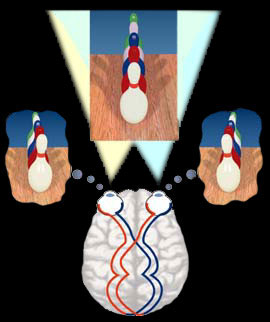|
Three-Dimensional Image, or 3-D image, flat image enhanced to impart the illusion of depth. Humans perceive the world and the objects in it in three dimensions-breadth, width, and depth. This seemingly simple phenomenon is the product of a complicated set of interactions between our eyes and our brains that is still not entirely understood. Our eyes are spaced about 6 cm apart, which causes each eye to receive a slightly different image. The brain fuses these two images into a single 3-D image, enabling us to perceive depth.
|
When you view an object, each eye focuses on that object, but because your eyes are separated from each other, the view from each eye is slightly offset. Each eye captures its image and transmits that image to your brain which does a lot more than fuse the two images into one; your brain filters and then processes the images to give you 3-D vision.
|
Two Eyes = Three Dimensions
|
Some of the Things 3-D Vision Helps You With:
Throw,
catch or hit a ball
Drive and park a car
Thread a needle and sewing
Reach out to shake someone's hand
Pour into a container
Step off a curb or step
Run downstairs
Climb down a ladder
Why some people have trouble seeing 3D
If you are having trouble seeing 3D, the first thing you need to do is find out whether you have binocular vision and stereo vision. You've got to have stereo vision to experience depth perception and 3D illusions.
Less than 5% of the population have severe visual disabilities that make stereo vision extremely difficult or impossible. This group includes those who have lost an eye or those with severe amblyopia (lazy eye) or strabismus (eye turns -- "crossed eyes" or "wall eyes").
Consider testing your own binocular vision with The Framing Game.
The Framing Game
 |
Focus your eyes on the single brown eye. |
 |
Continue to focus on the eye. If both eyes are on, you will see two thumbs framing one eye. |
 |
Now, switch your focus to your thumb. You should see two eyes framing one thumb. |
| [ home| perception| depth perception| context effects| 3D vision ] |
| [ autostereogram| effects of color| optical illusions| visual illusions ] |


